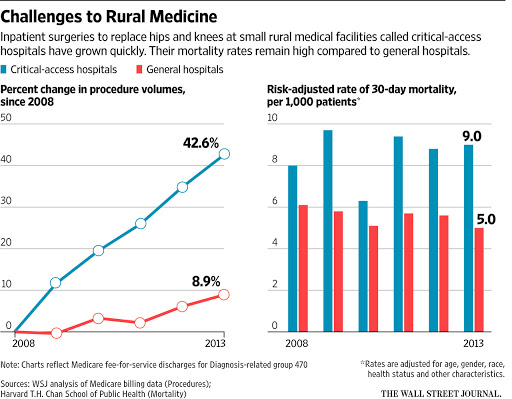Small, rural hospitals doing more orthopedic surgeries, but their 30-day death rate is one-third higher than that of larger hospitals

That’s what The Wall Street Journal found by reviewing Medicare billing data from 2008 to 2013, which showed a 43 percent increase in surgeries at critical-access hospitals, “far outpacing the growth of those services at general hospitals” and raising “troubling implications for patient safety,” says the Christmas Day story by Christopher Weaver, Anna Wilde Mathews and Tom McGinty. From 2010 to 2013, the death rate at such hospitals was 34 percent higher than at the larger facilities.
“Patients are getting bad outcomes, probably because they are getting procedures at hospitals without the experience to do it well,” Ashish Jha, a Harvard University public-health professor who has studied critical-access hospitals, told the Journal. He and his colleagues reviewed the Journal’s data and concluded that “the 30-day mortality rate for inpatient joint replacements was about 9
per 1,000 at critical-access hospitals in 2013, compared with around 5 in 1,000 at general hospitals,” the newspaper reports.
“Many studies suggest that patients generally get better results when their procedures are done at hospitals that perform them frequently,” the Journal reports. “The average critical-access hospital performing inpatient joint replacements in 2013 did about 26 that year, compared to about 132 at general hospitals. Hospitals doing more than 100 procedures a year have the lowest risks, said Nelson SooHoo, an orthopedic surgeon at UCLA’s David Geffen School of Medicine who has studied the issue.”
Kentucky has 29 critical-access hospitals. In general, such hospitals must have no more than 25 beds and keep patients no more than 72 hours. In return, the federal government gives them a small bonus on their Medicare and Medicaid payments, part of a policy Congress enacted to maintain the viability of hospitals in rural areas.
“Financial incentives can make doing more surgeries appealing to
critical-access hospitals, thanks to their special status with Medicare,
especially as the rural hospitals merge with larger rivals,” the newspaper notes. “The Journal’s analysis shows that the fastest-growing procedures at
critical-access hospitals are often-elective orthopedic surgeries that
could otherwise be scheduled at facilities with more experience. Experts say that as the hospitals’ experience grows, patients’ outcomes
should improve. But so far, mortality rates have held fast, according to
the analyses by the Journal and Harvard researchers.”
